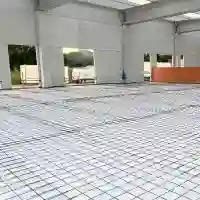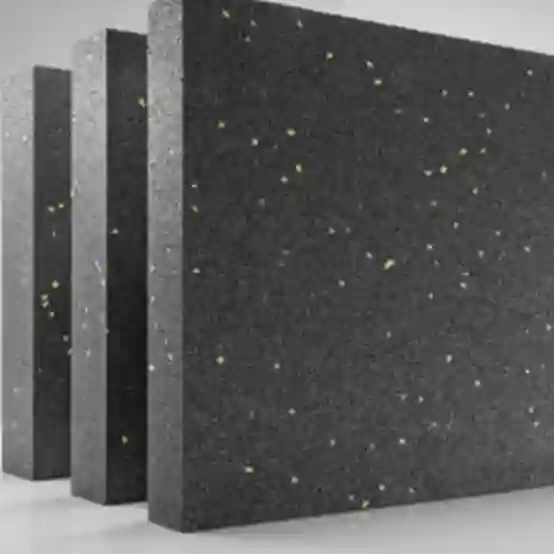The building envelope receives thermal performance enhancement through the use of polystyrene wall insulation panels which include EPS (Expanded Polystyrene) panels as their main type. The combination of light weight and affordable price and insulation performance makes EPS panels suitable for exterior wall construction. The article examines EPS panels through a detailed evaluation of their structure and benefits and drawbacks and their performance relative to alternative insulation materials.

What Are EPS Panels and How They Work in Exterior Wall Insulation
EPS panels function as fundamental elements in various building insulation systems because they provide strong thermal resistance and work well in different applications.
Composition and Structure of EPS (Expanded Polystyrene) Panels
EPS consists of rigid cellular plastic which originates from expandable polystyrene beads. The pre-expanded beads undergo steam heating to create blocks or shaped panels. The manufacturing process produces a closed-cell structure that maintains trapped air within its matrix which enables insulation.
HUASHENG provides its partners with high-performance EPS foam beads together with customized EPS foam solutions. Our team delivers precise and efficient solutions for all your EPS foam requirements including recycled materials and specialized products for various applications.
Thermal Performance Characteristics
EPS exhibits thermal conductivity values between 0.032–0.038 W/m·K based on its density level and the presence of additives. The material provides excellent performance in minimizing heat transfer through building wall structures.
The products demonstrate exceptional thermal insulation properties which help buildings decrease their energy usage.
Common Applications in Building Envelopes
EPS panels function as integral components of External Thermal Insulation Composite Systems (ETICS) which also operate under the name EIFS (Exterior Insulation Finishing Systems). The product serves applications for building new structures and for improving thermal performance of existing buildings.
Advantages of Using EPS Panels for External Wall Insulation
EPS panels provide construction projects with additional advantages beyond their basic thermal resistance properties.
Energy Efficiency and Thermal Insulation Benefits
A key aspect of building energy efficiency is minimizing unwanted heat transfer, with thermal insulation crucial for reducing heat loss.
Reduction in Heat Loss
EPS panels function as continuous exterior wall insulation because they minimize heat loss through their complete coverage of the exterior wall surface. The closed-cell structure of EPS panels maintains trapped air which minimizes heat transfer through conduction.
Contribution to Lower Energy Bills
EPS insulation in buildings helps buildings maintain constant indoor temperatures throughout the year which reduces the need for heating and cooling systems.
The thermal barrier they create enables consistent indoor temperatures which reduces the need for heating and cooling systems throughout the year.
Lightweight and Easy Installation Features
One of the standout advantages of this material is its lightweight nature, which greatly contributes to Simplified Handling and Transportation.
Simplified Handling and Transportation
EPS offers the benefit of lightweight construction because it has a low density that allows for simple on-site management without needing heavy equipment.
HUASHENG provides lightweight energy-efficient solutions through its recycled EPS foam and EPS foam beads which maintain their durability.
Compatibility with Various Finishing Systems
EPS boards are simple to cut into custom shapes and they work well with exterior finishes including stucco and render coatings and cladding systems. Their adaptable nature makes EPS boards suitable for architectural designs that require flexibility.
Moisture Resistance and Durability
Its ability to withstand moisture ensures long-term durability, making it ideal for Performance in Humid Climates.
Performance in Humid Climates
EPS material does not become completely waterproof but it absorbs water at a slow rate which stops moisture from entering wall spaces when vapor barriers are correctly installed.
Resistance to Mold and Mildew Growth
Polystyrene remains inert which prevents mold or mildew growth because dry polystyrene surfaces do not support microbial existence.
Cost-Effectiveness Compared to Other Insulation Materials
EPS stands as a cost-effective insulation material when compared to other widely used insulation products. The insulation provides long-term financial benefits through lower energy expenses and decreased maintenance costs.
The production of goods in local markets provides businesses with direct cost benefits.

Potential Drawbacks of EPS Panels for Exterior Use
The selection of EPS for external wall insulation requires evaluation of its specific limitations which exist despite its beneficial characteristics.
Fire Safety Considerations
When discussing fire safety in construction, the combustibility of materials like standard EPS grades demands thorough evaluation.
Combustibility of Standard EPS Grades
Standard-grade EPS has combustible properties which require protection through fire-resistant coatings or systems that fulfill fire code standards.
Importance of Flame Retardant Additives
The B1-grade EPS among modern flame retardant materials effectively reduces this risk.
Solution: B1 flame-retardant EPS particles (density 22kg/m³) The building achieved a total energy saving rate of 14% through this solution.
Environmental Concerns Related to EPS Production and Disposal
When addressing environmental impacts of EPS, its non-biodegradability during production and disposal raises significant concerns.
Non-Biodegradability Issues
The non-biodegradable nature of virgin polystyrene creates waste management problems when it reaches its end-of-life stage unless appropriate disposal methods are used.
Recycling Limitations and Solutions
Recycling infrastructure has experienced substantial development.
HUASHENG processes 300,000 tons of EPS waste per year which results in 1,500,000 tons of crude oil and 1,200,000 tons of carbon dioxide savings. Our company uses self-developed compactors to achieve maximum recycling efficiency.
Mechanical Strength Limitations Under Load or Impact
Standard-grade EPS works well for most façade applications but it will deform under heavy mechanical stress unless reinforced with mesh layers or combined with stronger materials in ETICS systems.
Comparing EPS with Other Exterior Wall Insulation Options
The evaluation of external wall insulation requires a comparison between different materials based on their performance characteristics.
EPS vs. XPS (Extruded Polystyrene) Panels
XPS provides superior moisture resistance because of its dense closed-cell structure although it costs more than foam board. The R-values per inch of both materials match but they serve different compressive strength requirements.
EPS vs. Mineral Wool Insulation Boards
Mineral wool provides better fire protection and sound insulation but its weight and cost exceed those of EPS. The water retention characteristics of mineral wool need precise handling during installation procedures.
EPS vs. Polyurethane Foam Systems
Polyurethane foams achieve higher R-values per inch but require specialized application techniques through spray-on methods which need experienced workers. Prefabricated polystyrene wall insulation panels provide simple on-site installation that requires basic equipment.
Key Factors to Consider Before Choosing EPS Panels for Exterior Walls
The selection of insulation materials requires evaluation of multiple project-related factors which extend past cost considerations and thermal efficiency requirements.
Local Climate Conditions and Building Codes Compliance
The selection of suitable panel grades including flame-retardant and graphite-enhanced variants becomes essential for regulatory compliance in areas with high humidity and extreme temperatures.
Our expandable polystyrene factory operates under complete environmental management systems.
Desired R-Value and Thickness Requirements
The selection of panel thickness depends on R-value targets because higher R-values need thicker boards or specialized graphite-infused panels which enhance performance without excessive size growth.
Compatibility with Wall Finishing Materials (e.g., Stucco, Cladding)
Choose a finish that sticks properly to polystyrene substrates since ETICS systems exist to work with materials such as stucco and synthetic renders that go over mesh-reinforced base coats.
HUASHENG: A Reliable Supplier of High-Quality EPS Products for Wall Insulation Projects
HUASHENG operates as a major company which delivers customized solutions to various business sectors including construction.
HUASHENG operates as a top EPS manufacturer which delivers premium EPS materials to different sectors including recycled EPS foam for circular economy applications.
Overview of HUASHENG’s Product Grades
The company produces three main EPS product lines which include standard EPS and flame-resistant EPS and graphite-enhanced EPS.
The REPS solutions provide additional value through their recyclable nature.
The production process follows specific requirements for each product line under REPS. The material meets all requirements for international PS recycling category 6.

Commitment to Quality Control and Customization Capabilities
The production line at Huasheng New Materials operates with modern intelligent systems to produce products that lead the industry in density uniformity and other key performance indicators.
Applications Across Residential, Commercial, and Industrial Sectors
HUASHENG achieved LEED Green Building Gold Certification status while delivering high-quality EPS foam products and creating a sustainable green environment.
Conclusion
In conclusion, EPS panels excel in exterior wall insulation for their energy efficiency, lightweight nature, and affordability. Yet concerns like combustibility and non-biodegradability must be addressed. Consider climate, fire codes, and recycling when choosing, and EPS can serve as a viable insulation solution.
FAQs:
Q1: How do standard EPS panels differ from flame-retardant grade panels?
A: Standard EPS panels are combustible and require treatment, while B1-rated flame-retardant EPS panels contain additives to control fire spread, meeting regulatory safety standards.
Q2: Are EPS panels effective in all climates?
A: Yes, EPS panels provide excellent thermal insulation across climates when installed with vapor barriers in humid areas, reducing heating and cooling needs.
Q3: Can stucco or paint be applied directly to EPS insulation panels?
A: Yes, EPS panels in ETICS systems support direct application of stucco or synthetic renderings with mesh-reinforced base coats, maintaining structural stability.






